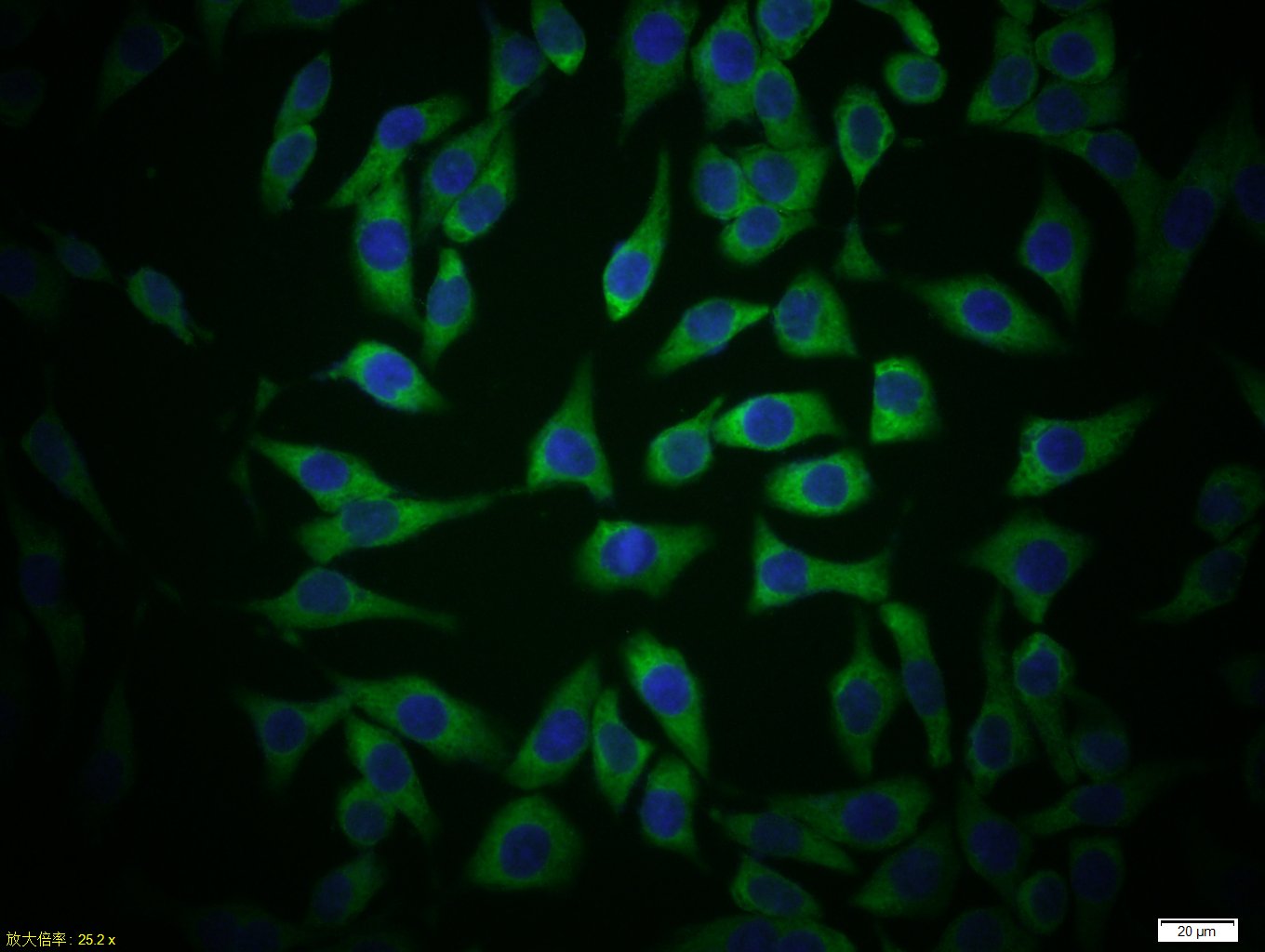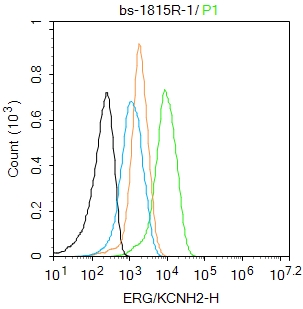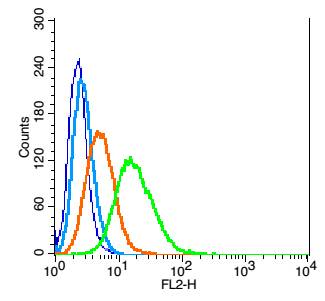
Rabbit Anti-ERG/KCNH2 antibody
ERG; ERG1; H ERG; HERG 1; HERG; HERG1; LQT 2; LQT2; Potassium channel HERG; SQT1; Voltagegated potassium channel, subfamily H, member 2; KCNH2_HUMAN.
View History [Clear]
Details
Product Name ERG/KCNH2 Chinese Name 特异性钾离子Channel protein抗体 Alias ERG; ERG1; H ERG; HERG 1; HERG; HERG1; LQT 2; LQT2; Potassium channel HERG; SQT1; Voltagegated potassium channel, subfamily H, member 2; KCNH2_HUMAN. literatures Research Area Tumour immunology Cyclin Channel protein Immunogen Species Rabbit Clonality Polyclonal React Species Human, Mouse, Rat, (predicted: Dog, Pig, Horse, Rabbit, ) Applications ELISA=1:5000-10000
not yet tested in other applications.
optimal dilutions/concentrations should be determined by the end user.Theoretical molecular weight 127kDa Cellular localization The cell membrane Form Liquid Concentration 1mg/ml immunogen KLH conjugated synthetic peptide derived from human HERG: 1001-1159/1159 <Cytoplasmic> Lsotype IgG Purification affinity purified by Protein A Buffer Solution 0.01M TBS(pH7.4) with 1% BSA, 0.03% Proclin300 and 50% Glycerol. Storage Shipped at 4℃. Store at -20 °C for one year. Avoid repeated freeze/thaw cycles. Attention This product as supplied is intended for research use only, not for use in human, therapeutic or diagnostic applications. PubMed PubMed Product Detail The potassium voltage gated channel, subfamily H (eag related), member 2 (KCNH2) gene encodes a voltage-gated potassium channel which has an important role in cardiac action potential repolarization in the mammalian heart. Mutations in KCNH2 have been shown to cause chromosome 7-linked congenital long QT syndrome, a disorder associated with delayed cardiac repolarization, prolonged electrocardiographic QT intervals, and the development of ventricular arrhythmias. KCNH2 channels are an important target for many drugs, and have emerged as a significant type of cardiac ion channel.Highly expressed in heart and brain.
Function:
Pore-forming (alpha) subunit of voltage-gated inwardly rectifying potassium channel. Channel properties are modulated by cAMP and subunit assembly. Mediates the rapidly activating component of the delayed rectifying potassium current in heart (IKr). Isoform 3 has no channel activity by itself, but modulates channel characteristics when associated with isoform 1.
Subunit:
The potassium channel is probably composed of a homo- or heterotetrameric complex of pore-forming alpha subunits that can associate with modulating beta subunits. Heteromultimer with KCNH6/ERG2 and KCNH7/ERG3. Interacts with ALG10B (By similarity). Heteromultimer with KCNE1 and KCNE2.
Subcellular Location:
Membrane; Multi-pass membrane protein.
Tissue Specificity:
Highly expressed in heart and brain.
Post-translational modifications:
Phosphorylated on serine and threonine residues. Phosphorylation by PKA inhibits ion conduction.
DISEASE:
Defects in KCNH2 are the cause of long QT syndrome type 2 (LQT2) [MIM:613688]. Long QT syndromes are heart disorders characterized by a prolonged QT interval on the ECG and polymorphic ventricular arrhythmias. They cause syncope and sudden death in response to exercise or emotional stress. Deafness is often associated with LQT2.
Defects in KCNH2 are the cause of short QT syndrome type 1 (SQT1) [MIM:609620]. Short QT syndromes are heart disorders characterized by idiopathic persistently and uniformly short QT interval on ECG in the absence of structural heart disease in affected individuals. They cause syncope and sudden death.
Similarity:
Belongs to the potassium channel family. H (Eag) (TC1.A.1.20) subfamily. Kv11.1/KCNH2 sub-subfamily. Contains 1 cyclic nucleotide-binding domain. Contains 1 PAC (PAS-associated C-terminal) domain. Contains 1 PAS (PER-ARNT-SIM) domain.
SWISS:
Q12809
Gene ID:
3757
Database links:Entrez Gene: 3757 Human
Entrez Gene: 16511 Mouse
Omim: 152427 Human
SwissProt: Q12809 Human
SwissProt: O35219 Mouse
Unigene: 647099 Human
Unigene: 6539 Mouse
Unigene: 10970 Rat
Product Picture
Primary Antibody (green line): Rabbit Anti-ERG/KCNH2 antibody (SL1815R)
Dilution: 1ug/Test;
Secondary Antibody : Goat anti-rabbit IgG-FITC
Dilution: 0.5ug/Test.
Protocol
The cells were incubated in 5%BSA to block non-specific protein-protein interactions for 30 min at room temperature .Cells stained with Primary Antibody for 30 min at room temperature. The secondary antibody used for 40 min at room temperature. Acquisition of 20,000 events was performed.Blank control: RSC96(blue).
Primary Antibody:Rabbit Anti- Cathepsin L antibody(SL1815R), Dilution: 1μg in 100 μL 1X PBS containing 0.5% BSA;
Isotype Control Antibody: Rabbit IgG(orange) ,used under the same conditions );
Secondary Antibody: Goat anti-rabbit IgG-PE(white blue), Dilution: 1:200 in 1 X PBS containing 0.5% BSA.
Protocol
The cells were fixed with 2% paraformaldehyde (10 min). Antibody (SL1815R, 1μg /1x10^6 cells) were incubated for 30 min on the ice, followed by 1 X PBS containing 0.5% BSA + 10% goat serum (15 min) to block non-specific protein-protein interactions. Then the Goat Anti-rabbit IgG/PE antibody was added into the blocking buffer mentioned above to react with the primary antibody of SL1815R at 1/200 dilution for 30 min on ice. Acquisition of 20,000 events was performed.
References (0)
No References
Bought notes(bought amounts latest0)
No one bought this product
User Comment(Total0User Comment Num)
- No comment





 +86 571 56623320
+86 571 56623320
 +86 18668110335
+86 18668110335

